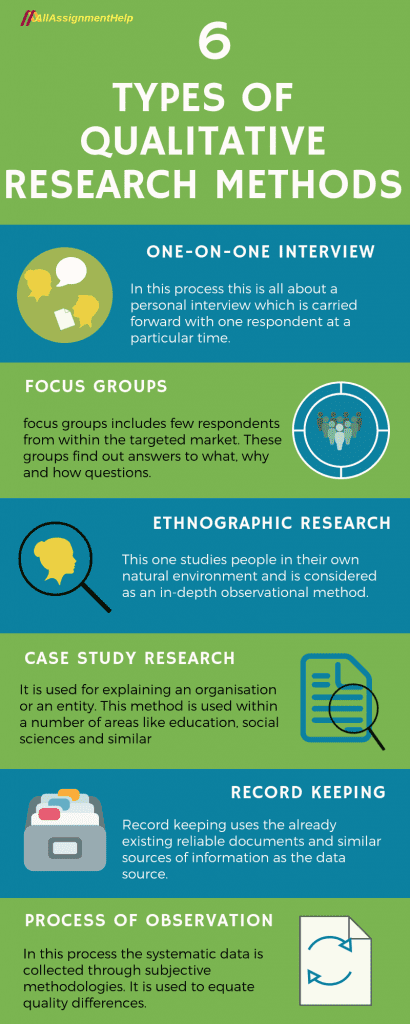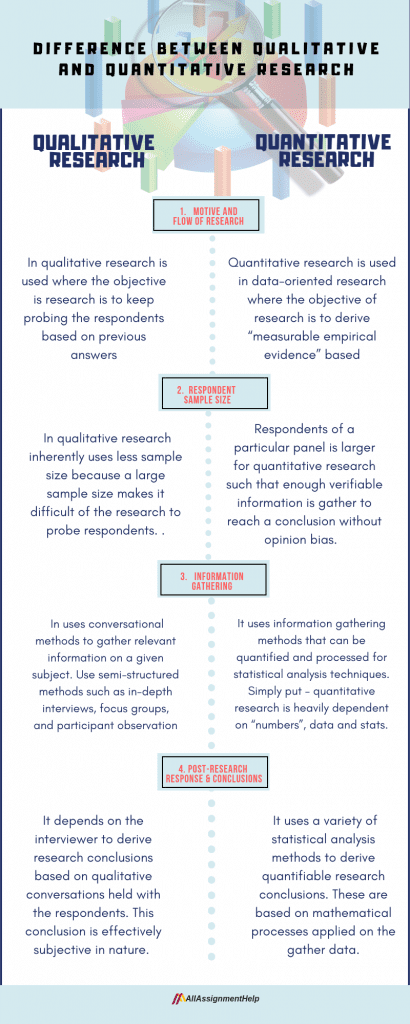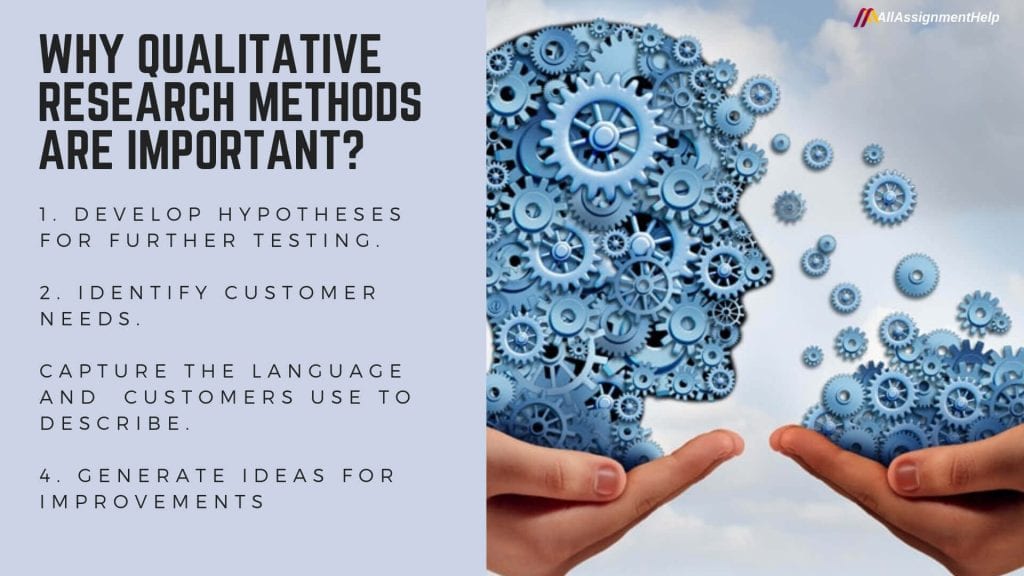Table of Contents
Hello folks. We’re back with yet another intriguing blog. This blog can be beneficial for you if you are a researcher or doctoral candidate. Do you know what is needed for writing a paper? This is research, in-depth research. An individual who has an understanding of qualitative research methods can write a good paper. However, sometimes the absence of a few essentials can make all your hard work in the research useless.
Are you curious about the essential things to keep in mind while doing research? Then, you are standing on a great platform. You will get to know the basics of qualitative research methods. From their definition to their importance and types, you will get to know everything about them.
This blog post from AllAssignmenthelp.com aims to provide you with a comprehensive understanding of Qualitative Research Methods, introducing you to the fundamental concepts behind this approach. Stay engaged with this write-up until the end to address all your inquiries related to the topic.
Let’s get started…
What Do You Understand By Qualitative Research?
To better comprehend ideas, opinions, or experiences, qualitative research gathers and analyzes non-numerical data (such as text, video, or audio). It can be used to get a comprehensive understanding of a situation or to come up with fresh research concepts. In short, Qualitative research is defined as a research method that focuses on obtaining data through open-ended and conversational communication.
This method is not only about “what” people think but also “why” they think so.
Let’s understand it with an example……
“A convenience store aimed to boost patronage. Observation revealed more male visitors. To understand low female visits, in-depth interviews were conducted with randomly sampled female customers from nearby stores. It became evident that the store lacked sufficient women’s items, leading to fewer female visits due to a higher focus on male products. Personal interactions unveiled this insight”
Hence, using qualitative research methodologies enable the interviewer or researcher to investigate and question individuals in greater detail based on their responses while also attempting to understand their purpose and feelings. We believe now you know the exact meaning of qualitative research.
Better Approaches For Conducting A Qualitative Research
Each strategy is briefly discussed in this section, along with any unique advantages or drawbacks. The internal consistency of each strategy may be more easily seen, and it is simpler to distinguish one approach from another by highlighting significant characteristics.
1. Questions
The quantitative research method utilises polls and surveys to gather information on a given subject. There is a varied range of survey questions based on the nature of the research study.
For Example: If you want to conduct customer satisfaction quantitative research, the Net Promoter Survey is one of the critically acclaimed survey questions for this purpose.
2. Distribution
Quantitative research uses email surveys as the primary mode of gathering responses to questions. Alternatively, technology has given rise to offline distribution methods for relatively remote locations using various mobile data capture apps available online. For social sciences and psychological quantitative research, social media surveys are also used to gather data.
3. Statistical Analysis
Quantitative research uses a wide range of data analysis techniques such as cross-tabulation, trend analysis and conjoint analysis.
Qualitative research methods originated in the social and behavioural sciences. Today our world is more complicated and it is difficult to understand what people think and perceive. Qualitative research methods make it easier to understand as it is more communicative and descriptive.
If you want some more examples and understand it better, taking online assignment help from a reputed online assignment help provider would be highly effective for you and resolve all your subjective queries efficiently.
Types of Qualitative Research Methods
Below are some of the types of qualitative research that are popular across diverse disciplines:
1. One-on-One Interview
Conducting in-depth interviews is one of the most common qualitative research methods. It is a personal interview that is carried out with one respondent at a time. This is purely a conversational method and invites opportunities to get details in depth from the respondent.
One of the advantages of this method provides a great opportunity to gather precise data about what people believe and what their motivations are. If the researcher is well experienced asking the right questions can help him/her collect meaningful data. If they need more information, researchers should ask follow-up questions that will help them collect more information
These interviews can be performed face-to-face or on the phone and usually can last between half an hour to two hours or even more. When the in-depth interview is conducted face to face it gives a better opportunity to read the body language of the respondents and match the responses.
2. Focus groups
A Focus group is one of the most commonly used qualitative research methods, practised in a focus group usually involving a limited number of respondents from your target market.
The main aim of the focus group is to find answers to the why, what and how questions. One advantage of focus groups is, you don’t necessarily need to interact with the group in person. Nowadays focus groups can be sent a survey online on various devices and responses can be collected at the click of a button.
Focus groups are an expensive method compared to other qualitative research methods. Typically they are used to explain complex processes. This method is very useful when it comes to market research on new products.
3. Ethnographic research
It is the most in-depth observational method that studies people in their naturally occurring environment.
This method requires the researchers to adapt to the target audiences’ environments which could be anywhere from an organization to a city or any remote location. Here geographical constraints can be an issue while collecting data.
This research design aims to understand the cultures, challenges, motivations, and settings that occur. Instead of relying on interviews and discussions, you experience the natural settings first-hand.
This type of research method can last from a few days to a few years, as it involves in-depth observation and collecting data on those grounds. It’s a challenging and time-consuming method and solely depends on the expertise of the researcher to be able to analyze, observe and infer the data.
4. Case study research
Case study methodology has evolved over the years and has developed into a valuable qualitative research method. As the name suggests it is used to explain an organization or entity.
This type of research method is used within a number of areas like education, social sciences and similar. This method may look difficult to operate. However, it is one of the simplest ways of conducting research as it involves a deep dive and thorough understanding of the data collection methods and inferring the data. Our experts can provide you with great case study assignment help if you want someone to help you with case study research.
5. Record keeping
This method uses already existing reliable documents and similar sources of information as data sources. This data can be used in any new research. It’s like going to a library. There one can go through books and other reference materials to collect relevant data which can possibly be used in research.
6. Process of observation
It is a process of research that uses subjective methodologies to gather systematic information or data. Since the focus on qualitative observation is the research process of using subjective methodologies to gather information or data. Qualitative observation is primarily used to equate quality differences.
Qualitative observation deals with the 5 major sensory organs and their functioning – sight, smell, touch, taste, and hearing. This doesn’t involve measurements or numbers but instead characteristics.
If you are a student struggling to manage your online classes that focus on qualitative research methods, and you find yourself thinking, ‘I wish I could find someone to take my online class for me,’ then seeking online class help can offer significant benefits. With this, you can improve your conceptual knowledge and pass with flying colours.
Read More: Writing Techniques: Why it is Important for Writers
Difference Between Qualitative & Quantitative Research
The goals of qualitative and quantitative research in education sometimes overlap, but in order to plan and carry out an effective research study, researchers need to be aware of the key components of each approach. To be able to decide which methodology is best suited to particular educational research issues, they must also be aware of the distinctions between qualitative and quantitative research.
Quantitative Research
Numbers and graphs are used to represent quantitative research. It helps to verify theories and presumptions. Discovering general information about a subject can be accomplished through this kind of study.
Experiments tallied observations, and surveys with closed-ended questions are examples of common quantitative research methods.
Qualitative research
Qualitative research is verbalized. It is applied to comprehend ideas, events, or concepts. You can learn detailed information on poorly understood subjects through this kind of study.
Open-ended questions in interviews, verbal descriptions of observations, and literature studies that examine concepts and theories are all examples of common qualitative procedures.
Now let’s compare the two research methods in depth:
1. Objective and flow of research
Quantitative research is used in data-oriented research where the objective of the research is to derive “measurable empirical evidence” based on fixed and pre-determined questions. The flow of research, is, therefore, decided before the research is conducted.
Whereas, qualitative research is used where the objective is research is to keep probing the respondents based on previous answers at the complete discretion of the interviewer. The flow of research is not determined and the researcher/interviewer has the liberty to frame and ask new questions.
2. Respondent sample size
Respondents of a particular panel are much larger for quantitative research such that enough verifiable information is gathered to reach a conclusion without opinion bias. In large-scale quantitative research, sample size can be in the thousands.
While qualitative research inherently uses less sample size because a large sample size makes it difficult for the researcher to probe respondents. For instance, a typical political focus group study evaluating election candidates involves no more than 5-10 panellists.
3. Information gathering
Quantitative research uses information-gathering methods that can be quantified and processed for statistical analysis techniques. Simply put – quantitative research is heavily dependent on “numbers”, data and stats.
On the other hand, qualitative research uses conversational methods to gather relevant information on a given subject.
4. Post-research analysis
Quantitative research uses a variety of statistical analysis methods to derive quantifiable research conclusions. These are based on mathematical processes applied to the gathered data.
Whereas, qualitative research depends on the interviewer to derive research conclusions based on qualitative conversations held with the respondents. This conclusion is effectively subjective in nature. This is why quantitative research recordings are often reviewed by senior researchers before the final research conclusion is drawn.
Let’s know a little more:
Table.1.0
| Qualitative Research | Quantitative research | |
| Focus | Exploring ideas or formulating a hypothesis | Testing hypotheses or theories |
| Analysis | Interpreting | Math or static |
| Expressed in | words | Numbers, graphs, tables, fewer words |
| Characterized by | Complexity, understanding, subjectivity | Testing, measurement, objectivity |
| Sample | Few respondents | Many respondents |
| Question | Open-ended | Close-ended |
Quantitative Research vs Qualitative Research
What Should Be The Process of Forming Qualitative Research Questions And Questionnaires?
To conduct qualitative research investigations, researchers must first ask the right questions. They are designed to aid in the exploration and understanding of phenomena, experiences, meanings, and viewpoints from the perspective of the participants. Here are some tips to help you write good qualitative research questions:
Mention the purpose of conducting qualitative research
It can be in the form of either of these sentences:
- This study will be on the topic of “Topic Name”
- The reason for conducting this research is “Purpose”
Create qualitative statements with a defined objective
Keep these pointers in mind while designing this statement:
- Try and form single-sentence statements. Single statements can be much more effective than elaborate ones as they help in communicating important messages in an impactful manner in a short and succinct sentence.
- Clarify the purpose of conducting qualitative research in clear words so that respondents understand their contribution towards this research.
- Mention the main topic of research that would prompt respondents to have a clearer idea about what they’re getting into.
- It’s the words that make all the difference. Use qualitative words that demonstrate the quality or feeling behind your purpose, such as understanding, describing, explore.
- Specify details that you would want to communicate to your respondents.
- Mention the name of the research website.
Create sub-questions to execute a purpose
- The main question might be – “What is the state of illiteracy in your state?”
- You can create sub-questions such as: “How does illiteracy hamper progress in your state?” or “How would you best describe your feelings about illiteracy?”
Highlight these questions using ‘qualitative’ words
- Start the questions with “What” or “How” to make sure the respondents provide details about their feelings.
- Communicate what you’re trying to “understand”, “explore” or “identify” using this Qualitative research online survey questionnaire.
- Questions such as “What happened” can be asked to develop a description of the topic.
- Questions about “how did respondents interpret the what happened question” can be asked to examine the outcome.
- Understand the entire qualitative research process by asking questions about “What happened to you with time?”
Why Qualitative Research Methods Are Useful?
Qualitative research methods are useful in various ways:
- Develop hypotheses for further testing and for quantitative questionnaire development,
- Understand the feelings, values, and perceptions that underlie and influence behaviour
- Identify customer needs
- Capture the language and imagery customers use to describe and relate to a product, service, brand, etc.
- Perceptions of marketing/communication messages
- Information obtained in a quantitative study and to better understand the context/meaning of the data
- Generate ideas for improvements and/or extensions of a product, line, or brand
- Uncover potential strategic directions for branding or communications programs
- Understand how people perceive a marketing message or communication piece
- Develop parameters (i.e., relevant questions, range of responses) for a quantitative study
When You Should Use Qualitative Research Methods?
Below is the list of ideas when you should use qualitative research methods:
- New product idea generation and development
- Investigating current or potential product/service/brand positioning and marketing strategy
- Strengths and weaknesses of products/brands
- Understanding dynamics of purchase decision dynamics
- Studying reactions to advertising and public relations campaigns, other marketing communications, graphic identity/branding, package design, etc.
- Exploring market segments, such as demographic and customer groups
- Studying emotions and attitudes on societal and public affairs issues
- Assessing the usability of websites or other interactive products or services
- Understanding perceptions of a company, brand, category and product
- Determining consumer language as a preliminary step to developing a quantitative survey
When You Should Not Use Qualitative Research Methods?
- Count, measure or offer statistical validation
- Determine the best product concept or price point or establish the importance of specific customer needs or satisfaction criteria
- Be a substitute for quantitative research because of time and/or budgetary constraints when quantitative evaluation is critical.
- Be a substitute for quantitative research because of time and/or budgetary constraints when quantitative evaluation is critical.
How to Examine both Qualitative and Quantitative Data?
Without analysis, qualitative or quantitative data cannot illustrate or prove anything; rather, they must be understood with regard to the study questions. Each sort of data requires a different analysis strategy.
Analyzing Quantitative Data
Numbers form the foundation of quantitative data. To find commonalities or trends in the data, simple algebra or more sophisticated statistical analysis is performed. Graphs and tables are frequently used to present the results.
Analyzing Qualitative Data
Analyzing qualitative data is more challenging than quantitative data. Instead of numbers, it contains text, pictures, or videos.
The following are some typical methods for assessing qualitative data:
- Monitoring the incidence, placement, and meaning of words or phrases is known as qualitative content analysis.
- Thematic analysis is the process of closely reviewing the data to find the key themes and trends.
- Discourse analysis: Examining how social settings affect communication.
Read More: Best Guide to Explain Informative Speech Topics Perfectly
Conclusion
The fundamental aspects of qualitative research methods are paramount for any aspiring researcher or scholar. The essence of qualitative research lies in its intricate yet invaluable approach to exploring the depth and nuances of human experiences, behaviours, and perceptions. Understanding the philosophical underpinnings, data collection techniques, and analysis procedures discussed in the blog post is the dynamic landscape for qualitative methods The emphasis is on reflexivity, subjectivity, and the iterative nature of the research.
Need Help? Come to Us
Research is not something too easy to do. If at any time you need help regarding this, you can come to us. At AllAssignmentHelp.com we are a group of subject matter experts with decades of experience
We can help you with every specific halt in your academic journey. If you feel any part of the research is tough to do you can take our research paper writing help and sort it out.
Thanks for reading…
FAQs
| Q1. What is research using mixed methods? Ans.1. To address your research issue, mixed methods research employs both qualitative and quantitative data gathering and analysis techniques. |
| Q.2. What exactly is a research project? Ans.2. A study is an academic, scientific, or professional initiative that aims to provide an answer to a research issue. Research projects might be qualitative or quantitative, descriptive, longitudinal, experimental, or correlational. Your topic will determine the research methodology you use. |



